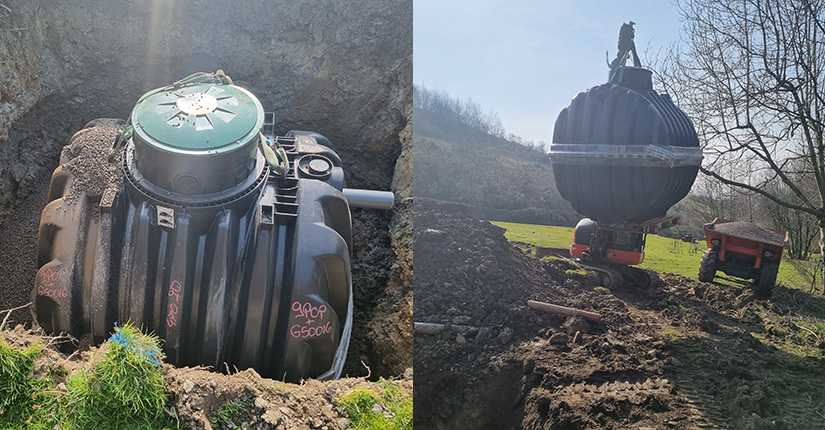Self-builders face particular challenges when it comes to wastewater drainage options, says David Stagg.
As summer sets in, the heat in the UK housing market shows no signs of cooling, with the predicted post-pandemic dip still to materialise.
While the self-build sector proved more resilient than the wider new housebuilding market during Covid, with completions falling by about 8% to around 13,900, new challenges are making themselves felt.
Although there are signs the exodus of people from cities to the country during Covid is reversing, there is still great demand for properties and plots of land in the rural areas that have traditionally been the popular hunting grounds for self-builders.
This has reduced the number and quality of plots available to self-builders to such a degree that many are now having to consider land they may have dismissed before because of drainage challenges such as unstable ground, a high water table, poor percolation in, for instance, clay ground, the availability of a well-percolated drainage field, or even suitable site layout as ideally a gravity fall is recommended on pipework to avoid having to use a pump. This can be further complicated if the plot is in a protected area requiring a special discharge licence from the Environment Agency.
Self-builders looking for a country plot are also frequently project managing the build themselves (typically 50%) while working the 9 to 5 from home … and that puts even more pressure on a prospective drainage system!
Wastewater management is a top priority for any property – but different property types often have distinct drainage requirements, and new builds can pose a number of specific challenges that need to be taken into account and handled carefully, particularly when it is a first-time project for the self-builder.
Many of the issues that arise with self-build properties are a consequence of the fact they are more often than not built from scratch, with no previous residents to stress-test the drainage or past history to establish how the new pipes and plumbing will cope with the realities of day-to-day use.
Drainage is one of the first elements of a self-build, with much of the subsequent construction sitting on top of it. Therefore, a mistake with the drainage may only become apparent once the build is complete and the owners have moved in, making these problems difficult to correct.
Common mistakes made during the drainage installation process include the selection of incorrect pipe sizes, wrong pipe gradients, erroneous cross-connections and poor backfilling. These problems can increase the risk of displaced pipes causing blockages, poor drainage, flooding or foul water being accidentally discharged into open watercourses, which is why it is so important to get this process right.
Many of these issues come up frequently when self-building and can cause considerable inconvenience and expense so it’s essential to bear in mind a number of best practice tips when designing a self-build drainage system.
One of the most valuable tips is to plan for the long term. The design of the drainage system should be future-proofed – building in the correct capacity to meet foreseeable future demands and any peaks and troughs in demand, and creating plenty of access points for maintenance and pumping out the sludge.
It’s also advisable to be proactive about drain care from day one. Self-builders moving into their newly completed property have a rare opportunity to make use of a drainage system that’s completely new, without any wearing or blockages caused by the bad habits of previous tenants. And it is important to keep it that way as there is no worse problem than a sewage one!
Self-builders could consider arranging for the drainage groundwork to be carried out by the groundworkers at the same time as, or straight after, the foundations. Diggers will be on site and the same lorries that remove the foundation spoil can take away the excess from the drainage trenches.
Those who utilise timber frame, where there is a long period between order and delivery, can choose to use that time getting the drainage done and then take the necessary precautions to prevent damage.
The groundwork element of a drainage installation is the most expensive, as the equipment, be it a cesspool, septic tank or wastewater treatment plant, is typically a fraction of the cost, so it’s important to optimise this. A soakaway may also be required if the system is not connected for surface water run-off.
Manufacturers of wastewater treatment systems who offer an approved network of fully trained installers (specialist contractors who install, commission, service and maintain systems), as well as extensive warranties in the event of an issue, should be a self-builders first port of call.
Some are even prepared to visit site to analyse all aspects of the scheme so the most cost-effective long-term solution can be designed. This is the time when specific site issues such as high-water tables/tidal waters can be identified and accounted for.
Bear in mind that while an intelligent wastewater treatment system may have more up-front costs, it is designed specifically to minimise long-term running costs. Those using the SBR (Sequence Batch Reactor) process control effluent quality discharge whilst being efficient on energy consumption. They can also automatically adapt to a system becoming under or over-charged, so performance is kept to a high standard and energy efficiency is not compromised.
Manufacturers can also advise on latest legislation such as the update to the General Binding Rules which is a bid by the Environment Agency to reduce the level of sewage pollution in the nation’s watercourses. Under the new rules, anyone with a septic tank discharging into a watercourse must replace it or upgrade the foul water solution.
Another is Natural England’s “advise” to local authorities to halt the determination of planning applications unless the developments can prove they will be nutrient (nitrogen and phosphate) neutral. High levels of these nutrients, which come partly from wastewater treatment discharges, cause excessive growth of green algae which smothers rare habitats and wildlife.
